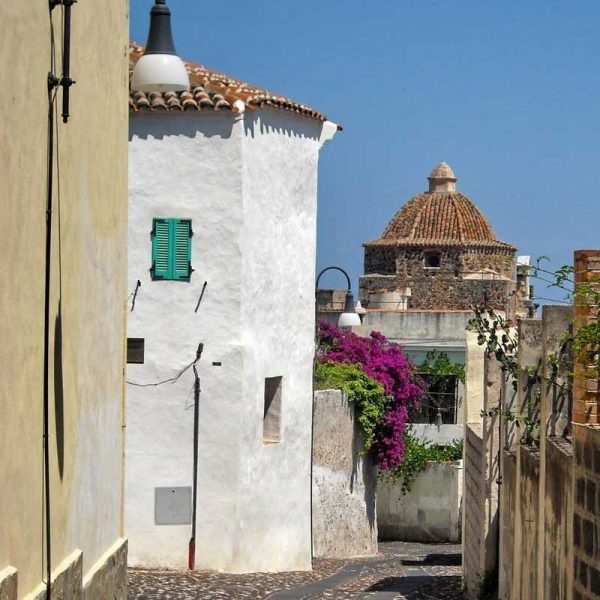We are 8 km from Orosei, a small town of 7000 inhabitants located in Baronia, a historical subregion of north-eastern Sardinia, in the province of Nuoro. In the Middle Ages Sardinia was under the Aragonese domination and the southern part of the Giudicato di Gallura was subdivided into Baronia di Posada and Baronia di Galtellì and Orosei.

CULTURE AND TERRITORY
CULTURE AND TERRITORY
We are 8 km from Orosei, a small town of 7000 inhabitants located in Baronia, a historical subregion of north-eastern Sardinia, in the province of Nuoro. In the Middle Ages Sardinia was under the Aragonese domination and the southern part of the Giudicato di Gallura was subdivided into Baronia di Posada and Baronia di Galtellì and Orosei.

THE GULF OF OROSEI
For more than 40 km this very high stretch of coast is characterized by imposing limestone bastions covered by centuries-old woods consisting of a luxuriant and variegated Mediterranean maquis. For centuries it remained inaccessible by land, it is formed by characteristic sandy beaches and surrounded by vertical limestone walls, carved by deep gorges carved by ancient rivers now disappeared. To preserve this territory which has remained uncontaminated for a long time and rich in animal and plant species of considerable interest, the National Park of the Gulf of Orosei and Gennargentu was established in 1998. The boat trip in the Gulf, to discover its paradisiacal beaches, will give you an unforgettable memory. The Grotta di Ispinigoli is located a few km from Dorgali and hides a stalagmite column among the highest in Europe. Also famous for the 60-meter swallow hole called “Abyss of the Virgins” that the Phoenicians used to make human sacrifices.
The Grotte del Bue Marino are coastal caves located in the territory of the municipality of Dorgali on the eastern coast of Sardinia. They are 15 km long and owe their name to the Sardinian name of the monk seal, a marine mammal believed to have disappeared from the area. The part that can only be visited from the sea is formed by a wide gallery and is rich in stalactites and stalagmites that are reflected in the clear waters of a wide salty underground lake (over 1 kilometer of surface, considered among the largest in the world) forming chromatic effects with multiple shades.
THE GULF OF OROSEI
For more than 40 km this very high stretch of coast is characterized by imposing limestone bastions covered by centuries-old woods consisting of a luxuriant and variegated Mediterranean maquis. For centuries it remained inaccessible by land, it is formed by characteristic sandy beaches and surrounded by vertical limestone walls, carved by deep gorges carved by ancient rivers now disappeared. To preserve this territory which has remained uncontaminated for a long time and rich in animal and plant species of considerable interest, the National Park of the Gulf of Orosei and Gennargentu was established in 1998. The boat trip in the Gulf, to discover its paradisiacal beaches, will give you an unforgettable memory. The Grotta di Ispinigoli is located a few km from Dorgali and hides a stalagmite column among the highest in Europe. Also famous for the 60-meter swallow hole called “Abyss of the Virgins” that the Phoenicians used to make human sacrifices.
The Grotte del Bue Marino are coastal caves located in the territory of the municipality of Dorgali on the eastern coast of Sardinia. They are 15 km long and owe their name to the Sardinian name of the monk seal, a marine mammal believed to have disappeared from the area. The part that can only be visited from the sea is formed by a wide gallery and is rich in stalactites and stalagmites that are reflected in the clear waters of a wide salty underground lake (over 1 kilometer of surface, considered among the largest in the world) forming chromatic effects with multiple shades.
TRADITIONS
THE LANGUAGE
In Sardinia you will hear people talking in Sardinian much more often than in Italian. With a very ancient origin, Sardinian can not be considered a dialect of Italian, but a real language, with its unique words, but also its own grammar and syntax.
THE COSTUMES
Enriched with precious finishing touches and jewels, the Sardinian costume represents an ancient way of dressing of the inhabitants of the different communities which, besides communicating the origin of the wearer, reveals the extraction and the social status. (Source)
In none of the other Italian regions are there so many traditional costumes as in Sardinia and every inhabitant wears it with pride as a testimony of their identity. The occasion to see them is to participate in a fair like the Sagra del Redentore in Nuoro. On this occasion you will also be able to discover unique masks such as those of the Mammuthones and the Issohadores that perform in ancient dances and songs.
THE MUSIC
The cantu a tenore is a style of choral singing of great importance in the Sardinian tradition. Artistic expression of original and native matrix and social expression of the agro-pastoral world, given its uniqueness and its beauty, in 2005 it was included by UNESCO among the oral and intangible heritage.
CRAFTSMANSHIP
The Sardinian handicraft, in particular in the province of Nuoro, has been able to keep its originality intact, thanks to the isolation that for centuries has characterized the entire area, preserving it from external influences. Among the typical handicraft products of the region there are tapestries and carpets, cutlery, ceramics, leather goods and coral filigree. At Ajo in Bidda, Via La Marmora 12, in Orosei, in the shop of a passionate lover, you will find many sought-after objects and an accurate explanation of their history, provenance and production methods.
RECOMMENDED BEACHES
BIDDEROSA
BERCHIDA
CAPO COMINO
ACTIVITIES
BOATS RENTAL
HORSE RIDING
QUAD EXCURSIONS
EVENTS
HOLY WEEK
Orosei - March or April
THE FEAST OF SANTA MARIA DEL MARE
Orosei - last Sunday of May
SAGRA DEL REDENTORE
Nuoro - last Sunday of August

